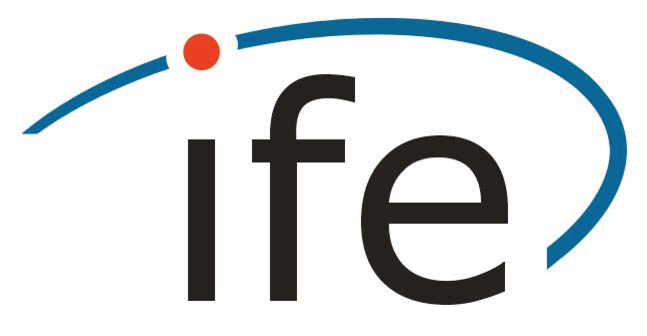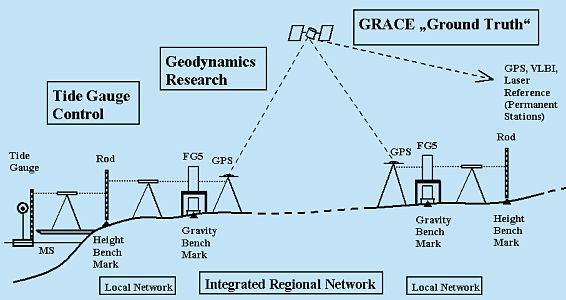Abgeschlossene Forschungsprojekte
-
Evaluation of CAI gradiometer for the gravity field determinationThe successful GOCE (Gravity field and steady-state Ocean Circulation Explorer) mission has demonstrated that the satellite gravity gradiometry can significantly improve our knowledge on the Earth’s gravity field, especially in the medium- and short-wavelength parts. However, the electrostatic gradiometer on-board GOCE satellite is not technically perfect because of the widely-known 1/f noise in the low-frequency parts of measurements. Comparatively, the Cold Atom Interferometry (CAI) based gradiometer has flat noise down to the very-low frequency part, and shows a very long-term stability as well. In this project, our tasks are to rigorously map the CAI gradiometer’s noise to Earth’s gravity field coefficients through closed-loop simulations, where a similar mission scenario as GOCE will be taken to study a one-axis and a three-axis CAI gradiometer in the nadir Earth-pointing mode.Leitung: Prof. Dr.-Ing. Jürgen MüllerTeam:Jahr: 2016Förderung: European Space Agency (ESA)Laufzeit: 2016-2017
-
Schwerefeldmodellierung zur relativistischen Geodäsie und vertikalen Datumsfestlegung (CRC 1128, C04)Leitung: Dr.-Ing. Heiner DenkerTeam:Jahr: 2014Förderung: Deutsche Forschungsgemeinschaft (DFG)Laufzeit: 01.07.2014 – 31.06.2018
-
International Timescales with Optical Clocks (ITOC) /Researcher Excellence Grant (REG) „Gravity Potential for Optical Clock Comparisons“Leitung: Dr. Helen S. Margolis, Dr.-Ing. Heiner DenkerTeam:Jahr: 2013Förderung: European Metrology Research Programme (EMRP), jointly funded by the EMRP participating countries within EURAMET and the European UnionLaufzeit: 01.07.2013 – 31.03.2016
-
The recovery of Earth’s global gravity field from GOCE observationsThe ESA’s GOCE (Gravity field and steady-state Ocean Circulation Explorer) mission was the first to jointly apply SGG (satellite gravity gradiometry) and SST-hl (satellite-to-satellite high-low tracking) techniques to map the Earth’s gravity field. It delivered hundreds of millions of observations in four years’ lifetime, from 2009 to 2013. My Ph.D work is to recover a global gravity field model that is described by 62,997 spherical harmonic coefficients (up to degree/order 250) from the huge amount of GOCE observations.Leitung: Prof. Dr.-Ing. Jürgen MüllerTeam:Jahr: 2011Förderung: Stipendium
![]()
![]()
-
REaldatenAnaLyse GOCE (REAL GOCE)Teilprojekt GOCE Cal/Val, Quasigeoid und Höhensystem in DeutschlandLeitung: Dr.-Ing. Heiner Denker, Prof. Dr.-Ing. Jürgen Müller (IfE-Anteil WP310)Team:Jahr: 2009Förderung: Sonderprogramm GEOTECHNOLOGIEN, gefördert vom Bundesministerium für Bildung und Forschung (BMBF) und der Deutsche Forschungsgemeinschaft (DFG), Förderkennz. 03G0726CLaufzeit: 01.06.2009 – 31.05.2012
![]()
![]()
-
GOCE-GRavitationsfeldANalyse Deutschland – GOCE-GRAND II WP220 – Regionales Validierungs- und KombinationsexperimentIm Rahmen des Projekts wurden hochwertige validierte terrestrische Schwerefelddatensätze (insbesondere Lotabweichungen und Schweredaten) in Deutschland und Europa zur externen Validierung der GOCE-Produkte erstellt. Diese Daten dienten einerseits zur Validierung vorhandener Satellitenschwerefeldmodelle und andererseits zur Berechnung entsprechender kombinierter Quasigeoidlösungen für Deutschland und Europa.Leitung: Dr.-Ing. Heiner Denker (WP220 - IfE)Team:Jahr: 2005Förderung: Sonderprogramm GEOTECHNOLOGIEN, gefördert vom Bundesministerium für Bildung und Forschung (BMBF) und der Deutsche Forschungsgemeinschaft (DFG), Förderkennz. 03F0421DLaufzeit: 01.09.2005 – 31.08.2008
-
Fennoskandische LandhebungEin Test- und Anwendungsgebiet für GRACELeitung: Prof. Dr.-Ing. Jürgen Müller, Dr.-Ing. Ludger Timmen, Dr.-Ing. Heiner DenkerTeam:Jahr: 2003Förderung: Deutsche Forschungsgemeinschaft (DFG)Laufzeit: 15.3.2003 bis 28.2.2009
![]()
![]()
-
Kombination von CHAMP- und regionalen terrestrischen SchwerefelddatenEvaluierung und optimalen Kombination verschiedener Schwerefelddatensätze in Europa.Leitung: Dr.-Ing. Heiner Denker, Prof. Dr.-Ing. Günter SeeberTeam:Jahr: 2001Förderung: Deutsche Forschungsgemeinschaft (DFG)Laufzeit: 01.05.2001 – 30.04.2004










